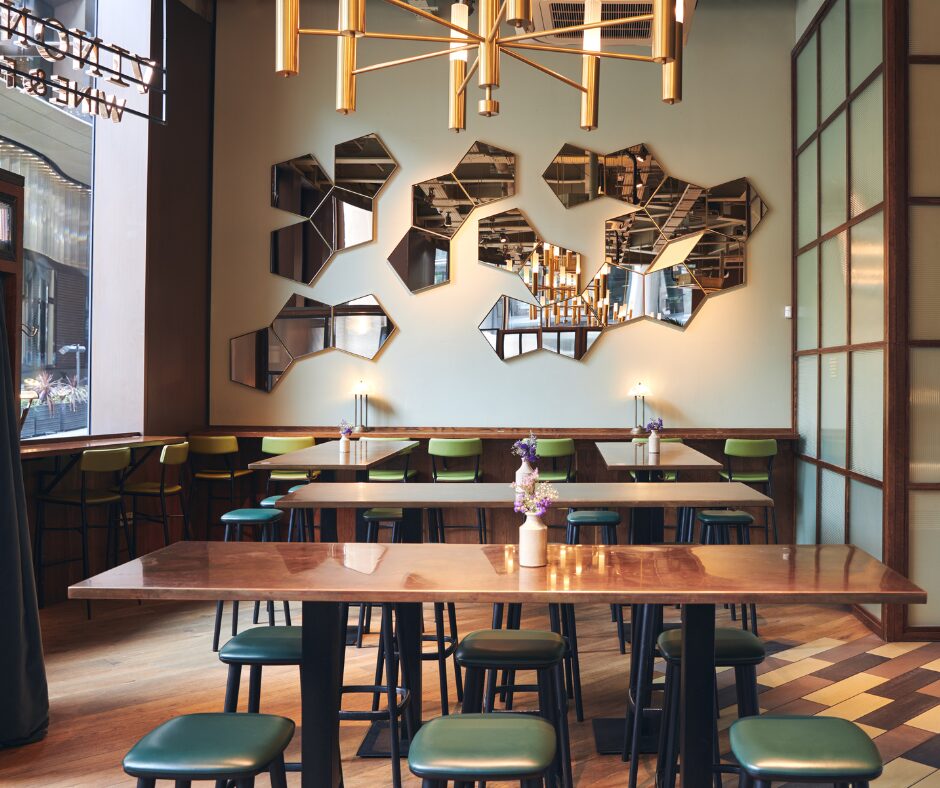
Designing and building a crave-worthy restaurant experience
Restaurant trends point to remodeling for delivery and customer care
In the competitive, high-stakes restaurant business, keeping pace with trends is key to staying alive. Like others, the restaurant industry has faced its share of challenges over the past five years, from pivoting to a pandemic-friendly business model to labor shortages, increasing costs, and evolving technology. Some of these shifts have taken root, and many have altered consumer behavior for the long term. But with the right design and build partner, you can remodel or construct to capture customer loyalty and delight them with a seamless experience.
So, what’s trending right now in the restaurant industry according to the data, and how can your restaurant portfolio grow in ways that make the most of these emerging and anticipated trends? Let’s take a closer look.
Top trends shaping the restaurant industry today
There’s a veritable feast of trends shaping the restaurant business in 2024-2025, which you may capitalize on by looking at them through the design and build lens. Whether you are a restaurateur or looking to enter the restaurant industry, it is possible to construct a new build or remodel an existing restaurant property to capture the opportunity resulting from these trends. Here’s what’s trending on the three-course menu of opportunities.
The Appetizer: Delivery
The pandemic pushed the food delivery trend to new heights, enabling consumers to stay safe at home while still enjoying the convenience and deliciousness of restaurant-quality food. Food delivery apps took off, with the online food delivery segment growing 27% in 2020 alone. Food delivery app revenue has increased threefold in the United States in the past five years and is expected to double by 2025, topping $42 billion. By next year, Statista anticipates food delivery will comprise more than 20% of the restaurant market share.
Current restaurant owners know the value and the challenges related to partnerships with third-party food delivery apps. Commission fees can cut deeply into restaurant profits, making third-party partnerships cost-prohibitive. At the same time, opting out of offering online ordering is becoming less and less of an option; consumers love the ease and speed of ordering online. Enterprising restaurant owner/developers may wish to expand their own delivery mechanism, building out their in-house capabilities. The public has become more educated about the true cost of these third-party apps (i.e., the burden on small business owners), and that’s something you can include in your marketing strategy as you launch in-house delivery options.
Remember, loyal customers are highly interested in retaining locally-owned businesses, including restaurants. To borrow from a well-known film, “If you build it, they will come…” to your website. While you work on upgrading your online ordering system, your design and build team of experts can help you work through the details of the building infrastructure you’ll need to support your new delivery capabilities.
The Entree: Virtual Restaurants
Restaurants come with a lot of overhead costs, and there’s no way around it. Or is there? Imagine a restaurant with no dining room, no front house staff, no paper menus, no tables and no bussing necessary. If it sounds like a dream to you, pinch yourself because this trend is already a reality.
They’re called virtual restaurants. They typically have an online presence and online ordering capability, but no customer dining room exists. Everything is ordered for pick-up or delivery. Virtual restaurants are also sometimes known as ghost kitchens or cloud kitchens, though there can be nuances between these if you want to split hairs. A virtual restaurant can operate out of its own space or an existing restaurant kitchen. In some cases, virtual restaurants are launched as an offshoot of a restaurant, sometimes focusing on a particularly popular item or streamlined menu. In some cases, virtual restaurants have even begun to expand into franchise territory.
Without the full-service offerings of a traditional restaurant, overhead costs are reduced, and profit margins can be higher than for a brick-and-mortar restaurant. Of course, a virtual restaurant still needs space for food preparation and the logistics of takeaway or delivery, so working with a trusted design and build team can ensure you get the setup necessary to deliver the food your customers want with the convenience they crave.
The Dessert: Automation
When it comes to the in-person restaurant world, automation is definitely hitting the sweet spot. Technology now enables customers to bypass the line with self-serve kiosks and settle their bills faster than ever with self-pay tablets. For owner/builders, the cherry on top is again lower overhead as staffing needs are reduced and table turnover times are faster. Studies show that self-pay tablets reduce dining time by six to nine minutes. Even sweeter: table-top tablets have been shown to improve the sales of desserts by 30%.
Ready to design and build a restaurant in La Crosse, WI, or Rochester, MN?
Building and remodeling for these trends is essential to remaining competitive in the restaurant industry, and partnering with a reputable commercial construction general contractor you trust lays the groundwork for your restaurant’s future success. Building to capture opportunities that arise from trends requires a rock-solid strategy and a proven approach to construction. The design and build model of construction provides an invaluable framework that brings a team of knowledgeable professionals to the collaboration table, so your project adheres to timelines and avoids the pitfalls of costly change orders. Contact us when you’re ready to explore the benefits of design-build to make your restaurant experience as crave-worthy as your food.